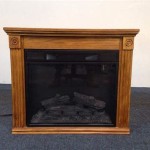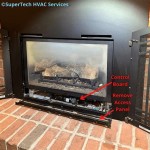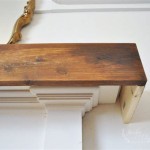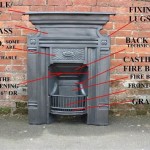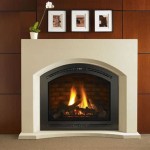Installing a Fake Brick Fireplace: A Comprehensive Guide
Installing a fake brick fireplace can significantly enhance the aesthetic appeal of a living space without the expense and structural modifications associated with installing a real masonry fireplace. This guide will provide a detailed overview of the process, encompassing planning, material selection, installation techniques, and safety considerations.
The decision to install a fake brick fireplace, also known as a faux brick fireplace, often stems from a desire for visual warmth and texture. Real brick fireplaces require significant structural support, flue systems, and professional installation, making them a costly and disruptive undertaking. Fake brick offers an accessible alternative, enabling homeowners to achieve a similar look with relative ease and affordability. Before commencing the installation, a thorough understanding of the project scope and individual skill level is crucial.
Planning and Preparation
Effective planning is paramount to a successful fake brick fireplace installation. This phase comprises several critical steps, including defining the desired aesthetic, measuring the installation space, selecting appropriate materials, and acquiring necessary tools. The visual style should complement the existing décor of the room. Consider factors such as brick color, texture, and arrangement pattern to achieve the desired effect. Browse online resources, home décor magazines, and model homes for inspiration.
Accurate measurements of the designated fireplace area are essential for determining the quantity of materials required. Measure the width, height, and depth of the proposed fireplace, accounting for any existing architectural features such as baseboards, trim, or electrical outlets. It is advisable to create a detailed sketch of the fireplace design, incorporating dimensions and material specifications. This sketch will serve as a visual guide throughout the installation process.
Material selection is a crucial determinant of the fireplace’s final appearance and durability. Several options are available, each with its own advantages and disadvantages. Brick veneer panels, individual faux brick tiles, and lightweight brick alternatives are commonly used. Brick veneer panels offer ease of installation, as they consist of large sections that can be quickly applied to the wall. Individual faux brick tiles provide greater design flexibility, allowing for custom patterns and grout lines. Lightweight brick alternatives are typically made from concrete or other composite materials, offering a balance of durability and affordability. Research the available options and select materials that align with budget constraints and desired aesthetic qualities. A quality adhesive, appropriate for the selected materials and wall surface, must also be chosen.
Gather all necessary tools and equipment before starting the installation. This may include a measuring tape, level, pencil, circular saw or tile saw (depending on the material chosen), trowel, notched trowel, adhesive, grout (if desired), grout sponge, safety glasses, and work gloves. Proper safety gear is essential to protect against potential hazards such as dust, debris, and sharp edges.
Installation Techniques
The installation process will vary depending on the specific materials chosen, but generally follows a similar sequence of steps. Proper surface preparation is crucial for ensuring a secure and long-lasting bond between the fake brick and the wall. Clean the wall thoroughly to remove any dust, dirt, grease, or loose paint. Repair any cracks or imperfections in the wall surface. If the wall is drywall, apply a coat of primer to improve adhesion.
Next, measure and mark the location of the fireplace on the wall. Use a level to ensure that the placement is straight and square. If installing brick veneer panels, begin by applying a bead of adhesive to the back of each panel. Carefully position the panel against the wall, aligning it with the marked guidelines. Apply firm pressure to ensure a strong bond. Repeat this process until the entire fireplace area is covered.
If installing individual faux brick tiles, apply a thin layer of adhesive to the back of each tile using a notched trowel. The notched trowel helps to distribute the adhesive evenly and create a stronger bond. Position the tile against the wall, leaving a consistent gap between each tile for grout lines. Use spacers to maintain uniform spacing. Continue this process until the entire fireplace area is covered. Allow the adhesive to dry completely according to the manufacturer's instructions. The drying time may vary depending on the type of adhesive used.
Grouting is an optional step that can enhance the appearance of individual faux brick tiles. If desired, apply grout to the gaps between the tiles using a grout float. Press the grout firmly into the gaps, ensuring that they are completely filled. Remove any excess grout from the surface of the tiles using a damp sponge. Allow the grout to dry according to the manufacturer's instructions. Once the grout is dry, buff the tiles with a clean cloth to remove any remaining residue.
Trim and edging can be added to complete the fireplace surround. This can be achieved using wood trim, metal trim, or other decorative elements. Measure and cut the trim to the desired length and angle. Attach the trim to the fireplace surround using adhesive or nails. Caulk any gaps between the trim and the wall to create a seamless finish. Select complementary paint or stain for the trim to blend with the overall aesthetic of the fireplace.
Safety Considerations
Safety should be prioritized throughout the entire installation process. Wear safety glasses to protect eyes from dust and debris. Use work gloves to protect hands from sharp edges and adhesive. Ensure adequate ventilation in the work area to prevent the buildup of fumes from adhesives or sealants. When using power tools, follow the manufacturer's instructions carefully and wear appropriate safety gear, such as hearing protection and a dust mask.
It is crucial to maintain a safe distance from any heat source when installing a fake brick fireplace. Do not install the fake brick directly onto a functional fireplace that generates heat. The fake brick is primarily for decorative purposes. It should be installed around a non-functional fireplace or an electric fireplace insert designed for this purpose. Consult local building codes and regulations to ensure compliance with fire safety standards.
Proper handling and disposal of materials are also important safety considerations. Follow manufacturer’s instructions for safe handling and storage of adhesives, sealants, and other chemical products. Dispose of waste materials according to local regulations. Avoid inhaling dust or fumes from construction materials. Clean up any spills or messes immediately to prevent accidents. Always keep a fire extinguisher readily available in the work area.
Electrical safety is crucial if the fireplace installation involves electrical components, such as lighting or an electric fireplace insert. Turn off the power to the circuit before working on any electrical connections. Use appropriate wiring and connectors for the electrical load. If unsure about electrical work, consult a qualified electrician. Ensure that all electrical components are properly grounded and comply with local electrical codes.
Inspect the completed installation thoroughly to ensure that all materials are securely attached and there are no safety hazards. Check for loose tiles, gaps in the grout, or exposed edges. Make any necessary repairs or adjustments to address any issues. Clean the finished fireplace to remove any dust or debris. Enjoy the newly installed fake brick fireplace, adding warmth and character to the living space.

If You Re Going To Make It Better Fake Diy Brick Fireplace

How To Diy Faux Brick Fireplace Shiplap The Simple Cozy Haven

Building An Electric Fireplace With Brick Facade

If You Re Going To Make It Better Fake Diy Brick Fireplace

Diy Faux Fireplace For Under 600 The Big Reveal Bless Er House

How To Build A Diy Electric Brick Fireplace Hilltown House

How To Diy Faux Brick Fireplace Shiplap The Simple Cozy Haven

White Brick Fireplace Diy Build With Faux Barron Designs

Diy Faux Fireplace Mantel With Tile And Brick

How To Install Thin Brick Veneers On Your Fireplace
Related Posts

